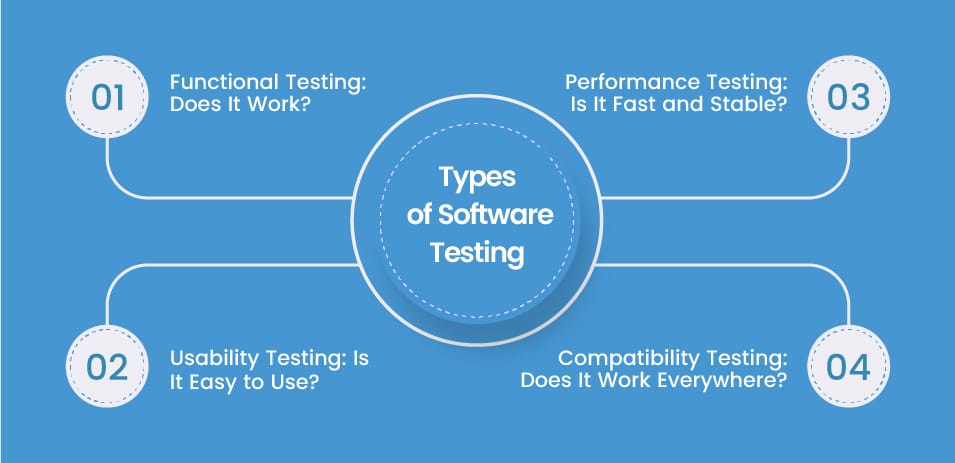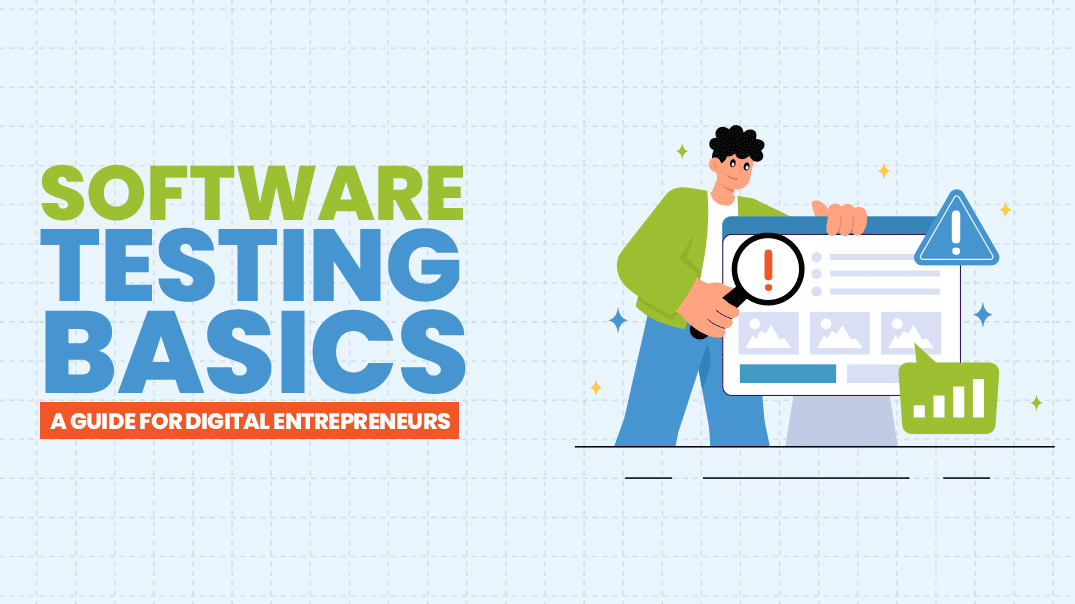Table of Contents
ToggleAs a digital entrepreneur, you have a great idea for your software product and you’re focusing on design, features, and launch. However, there’s one crucial step that many entrepreneurs often overlook, which can make or break their success: software testing. It’s not just a technical chore; it’s a vital business practice that protects your reputation, saves money, and delivers pleasing experiences. Think of it as the final quality check before you open your doors for business. In this blog, we will address software testing basics, types of testing, and why it’s important. If the content feels too dry to read, please reach out to us to schedule an interactive session, which would be much more engaging.
Why Is Testing Important for Your Business?
Testing is your best defense against failure, especially when an app involves valuable fan content or transactions. Skipping it can lead to frustrating bugs, bad reviews, and lost customers, who won’t even add a review or leave a complaint. Still looking for more reasons? Go ahead, have a nice read.

Saves Time and Money
Finding a bug after launch is expensive and time-consuming, let alone more difficult to fix. It may require emergency patches and development resources while risking live performance. Testing helps you catch these issues earlier and rectify them when they’re cheaper and easier to fix.
Protect Your Brand Reputation
First impressions matter; that’s why we chose to refer to you as digital entrepreneurs. A buggy, slow, or broken application can damage your brand’s credibility before falling into the darkest pits. Investing in testing mechanisms reflects your professionalism and how seriously you maintain your digital assets.
Ensure a Great User Experience
Testing goes beyond finding bugs; it verifies that your software is intuitive and easy to use. A positive user experience leads to higher engagement, better retention, and stronger word-of-mouth marketing. Quality testing shows your customers that you care about their experience and deliver a product they can trust.
Types of Software Testing
Software testing can be broken down into a few key categories, not to pick a few and drop others, but according to purpose. As an entrepreneur, you should be aware of these to ensure your product is ready for the market. Here is a brief introduction to each type, along with its reasoning and impact.

Functional Testing: Does It Work?
It verifies that every button, feature, and function operates as intended according to the plan. For example, does the ‘login’ button open a login form? Does the shopping cart calculate the total correctly? Do each of your payment options work correctly and perform transactions without errors?
Usability Testing: Is It Easy to Use?
This type focuses on the user experience and user journey for different workflows. It answers questions like: Can a new user navigate the software without a tutorial? Is the layout clean and logical? Good usability makes your product a joy to use, not a chore. The flow must be smooth and self-explanatory.
Performance Testing: Is It Fast and Stable?
Performance testing ensures your software can handle real-world conditions and limitations. It checks how the app performs under heavy loads or with many users at once. This prevents your software from crashing on a busy sales day and performs optimally regardless of the feature or process in use.
Compatibility Testing: Does It Work Everywhere?
With numerous devices and browsers in use, your software must work on all of them. Compatibility testing ensures your product looks and functions correctly on various platforms, screen sizes, and operating systems. It also assesses the functionality of all software features under poor network strength.
How to Approach Testing as an Entrepreneur?
You don’t need a massive budget to start testing, nor a lot of time in case of a closing in launch. Here’s a simple approach that adheres to all the details while also being pretty impactful.

Start with Manual Testing
Put yourself in your user’s shoes. Click every button, fill out every form, and try to break the app. This simple, hands-on approach can catch many obvious issues before anyone else sees them.
Get Feedback from Beta Testers
Launch a private beta with a small group of trusted users. Their real-world feedback can uncover bugs you never anticipated. This also helps build a small community of early adopters.
Partner with a Professional QA Team
For complex projects, consider hiring a quality assurance team. They are experts in finding subtle bugs, security vulnerabilities, and performance issues that you might miss. This is an investment in your product’s long-term health, which pays back manifold in the long run.
Software Testing Basics
Software testing is an ongoing process, woven into every stage of the Software Development Life Cycle, or simply, SDLC. By initiating testing early and keeping it ongoing, teams can prevent defects from entering the final product, which is far more efficient than fixing them later. It begins by ‘verifying the test basis’ through designing tests as per core documents, such as requirements and design specifications.
Approaches to Testing
Testing activities can be broadly categorized into the following two types, which are easily memorable.
Static Testing
This method enables you to identify defects without requiring a single line of code. Static testing involves carefully reviewing project documents and the source code itself through activities like walkthroughs, inspections, and formal reviews. Because it catches mistakes at the earliest stages, this is a highly effective and cost-efficient way to ensure quality.
Dynamic Testing
In contrast to static testing, dynamic testing requires the software to be executed. This is where the code is run to assess its performance in real-world scenarios. A few subcategories are:
- Unit Testing – Checking individual code components
- Integration Testing – Seeing how different elements work together
- System Testing – Testing the entire system as a whole
The Core Activities of the Testing Process
When it comes to software testing basics, a successful project follows a clear set of activities. It is crucial to grasp what each stage covers rather than skimming through the headings, which can be confusing.
Planning
Plan what needs to be tested, define the testing goals, and establish KPIs to track progress and report on status.
Preparation
This is the phase where we prepare for execution, and it is a crucial stage requiring deep consideration. We select the specific test conditions and design detailed test cases that will be used for evaluation.
Evaluation
During this final stage, we analyze the test findings. We evaluate the software’s performance against predefined criteria to determine whether it has satisfactory results and is ready for release.
What Gets Tested
Testing is not limited to just the code. It is equally important to test the quality of all related documents, known as ‘work products.’ It includes reviewing the initial requirement specifications, design documents, and user-facing materials such as operation guides, training manuals, and user guides to ensure accuracy.
Conclusion
Software testing basics are integral to building successful digital products. It’s not a cost; it’s an investment in your reputation, customers, and business growth. As a crucial part of any project, it is an ongoing process that builds quality from the very beginning. Both static and dynamic methods find defects early, protecting your brand and saving you time and money. By prioritizing quality, you can launch a product that is reliable, secure, and set for long-term growth. Unique Software Development is a reliable partner for developers, entrepreneurs, and enterprises across the US, offering testing services, among others.















